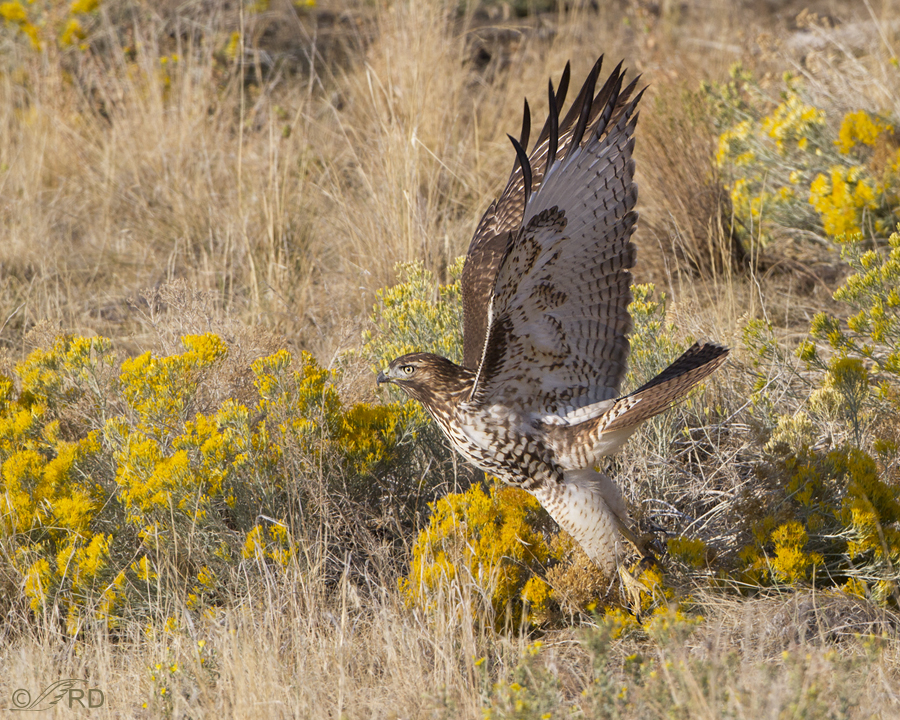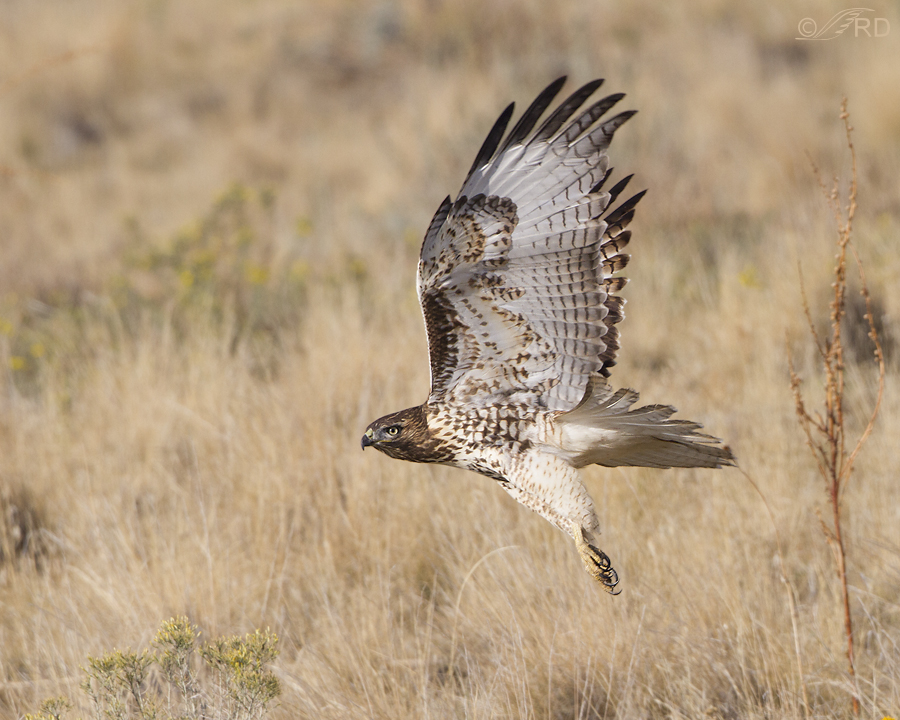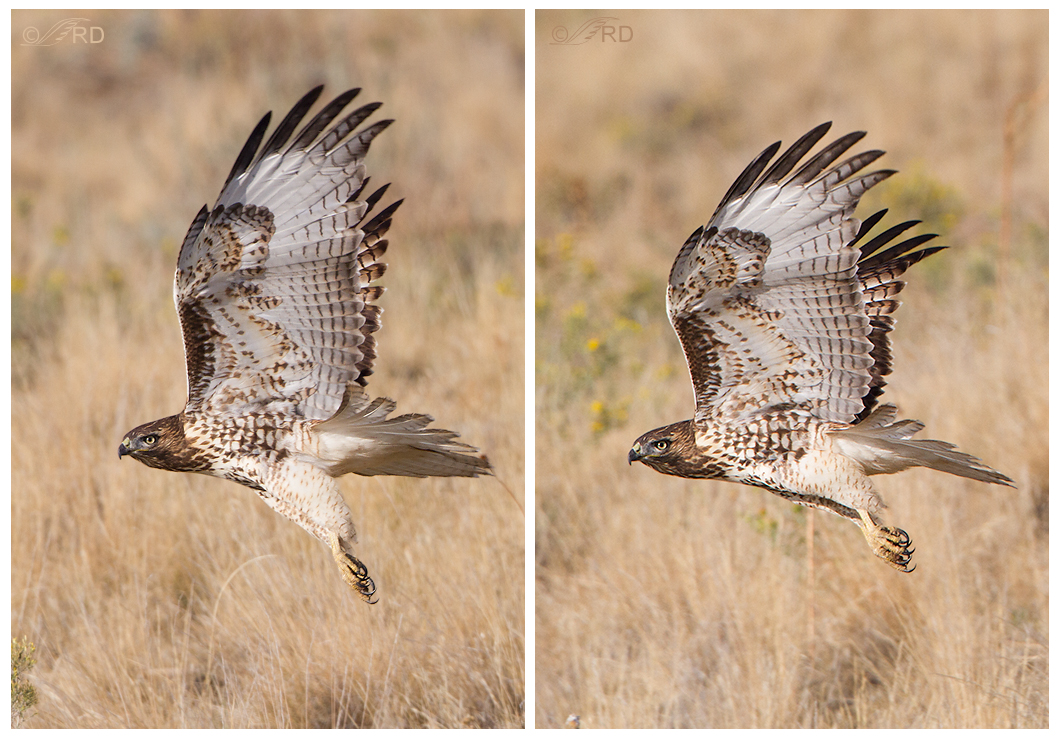I love the fall colors of the blooming rabbitbrush on Antelope Island. I’m always looking to photograph songbirds perched on it because it can make such an attractive setting but for some reason they don’t often use it for a perch.
But about two weeks ago I was able to get some images of this juvenile Red-tailed Hawk with blooming rabbitbrush in the setting and even though, in many of those photos, the rabbitbrush is a little “busy” and takes attention away from the bird, I still liked the shots for a change of pace from the soft, unidentified bokeh that is often preferred in avian photography. Some of these shots show habitat well and sometimes that’s a good thing…

1/2000, f/7.1, ISO 500, 500 f/4, natural light, not baited, set up or called in
This bird had been “sit and wait” hunting as it was perched very low and close to me on a rusty, metal gate when it spotted something at the base of this rabbitbrush and flew in for the capture. At first I thought it had been successful because the hawk was “mantling” (spreading wings and tail over prey to hide it from potential competitors) but in the end it came up empty-taloned.

1/2000, f/7.1, ISO 500, 500 f/4, natural light, not baited, set up or called in
So it soon flew off and I was able to get some shots as it did so. I like the dynamic take-off posture in this image, though some may find that the relative sharpness and bright colors of the rabbitbrush in the setting detract from the bird.

1/2000, f/7.1, ISO 500, 500 f/4, natural light, not baited, set up or called in
In the very next shot of the burst the wings were in the down position and hiding much of the brightest rabbitbrush.

1/2000, f/7.1, ISO 500, 500 f/4, natural light, not baited, set up or called in
Two shots later the wings are again in the down position and the hawk is more isolated from the rabbitbrush.
Yes, I do have a point to make about wing positions.

1/2000, f/7.1, ISO 500, 500 f/4, natural light, not baited, set up or called in
Three images later, the wings are up. Notice that in none of the shots were the wings in an intermediate or horizontal position and that in all the even-numbered shots (you’ll see the file numbers by passing your cursor over the image) the wings are up and in all of the odd-numbered shots the wings are down.
I’ve mentioned before that the burst rate of my Canon 7D (8 shots per second, with a fast memory card) seems to be perfectly choreographed with the wing beat rate of a large raptor when it’s taking off. This is both the curse and the blessing of the 7D – a blessing when it catches wings in the up or down positions (which most photographers prefer) and a curse when it catches them in the much less desirable horizontal position. I’ve taken up to 8 – 10 consecutive shots of a raptor taking off where every one of the images shows the bird with its wings straight out (horizontal) – not a good thing…
Because of this synchronicity, consecutive odd or even-numbered images can be almost shockingly similar. At first glance these two shots almost look like the same photo but they are consecutive even-numbered images (7476 and 7478) – and yes, #7477 had the wings in the full down position but I clipped one of the wings in that photo.
All of this is likely of little interest unless you’re a photographer but it’s something I have to pay attention to as I photograph birds in flight – particularly raptors as they’re taking off.
Ron



Ron:
Interesting point about the synchronicity. It isn’t something I had noticed. Perhaps because I shoot a lot of “slow-flappers” I tend to get a mix of wings up, down, and intermediate. Different camera, but almost the same frame rate.
I love the first (bird in habitat) shot.
Dave
Thanks Dave. I’ve noticed that synchronicity only with raptors about the same size as red-tails as they’re taking off. It often happens with Swainson’s too.
Ron, because of you, I pay a lot of attention to wing position now … even if I can’t execute it perfectly all of the time. It’s something that as a neophyte photographer I couldn’t even think about while just trying to get the shot, but I’m grateful for your expertise in always honing the expectations. I’m still in admiration of how beautifully you get it just right, with perfect light, as well. It’s so difficult when you consider how easily shadows are cast in these situations and how visually complex those mid-range wing positions are.
Thank you, Ingrid – for “getting it” about the wing positions and from your comment I can tell that you do.
I also liked the third photograph, for the sense of movement and the almost fan like position of the wings. Thank you.
I like that shot too Elephant’s Child, for the same reasons you mention.
Hmm, never thought about that before, but it’s hard to argue with the math and the pictures. Another insight I got from your photo sequence was something quite obvious that has never registered with me: the position of the tail relative to the wings during takeoff. When a bird takes off it’s wings must go upward before they can dig deep into a down stroke for lift. The tail goes up as well(!), then drops in concert with the wing’s down stroke. Three large surfaces are being used to create initial lift, not just two. Whaddayaknow. Thanks Ron!
Exactly, Mike! It’s a recurring theme when they take off from the ground or a very low perch. In that situation they need all the lift they can get so the tail goes up with the wings and then all three go down to get that extra bit of lift. When they take off from an elevated perch it usually doesn’t happen unless they feel the need to gain elevation fast.
Thanks for the info. I love all the shots–rabbitbrush or no. I especially love the third image in your post. The clarity of the wing structure is fabulous and l love the little peek at the underside of the right wing. As always–beautiful.
Thanks Sharon. I’m always interested in which shot might appeal to folks most so I appreciate you pointing out your favorite, and why.
You are certainly most educational and entertaining at the same time! I love these shots and the beautiful juvenile red tail in them. Rabbit brush is beautiful, but it is my nemesis, as it makes me sneeze!
Thank’s Tana. Hmmmm, perhaps that’s why the songbirds seldom perch on rabbitbrush – they have allergies. 🙂